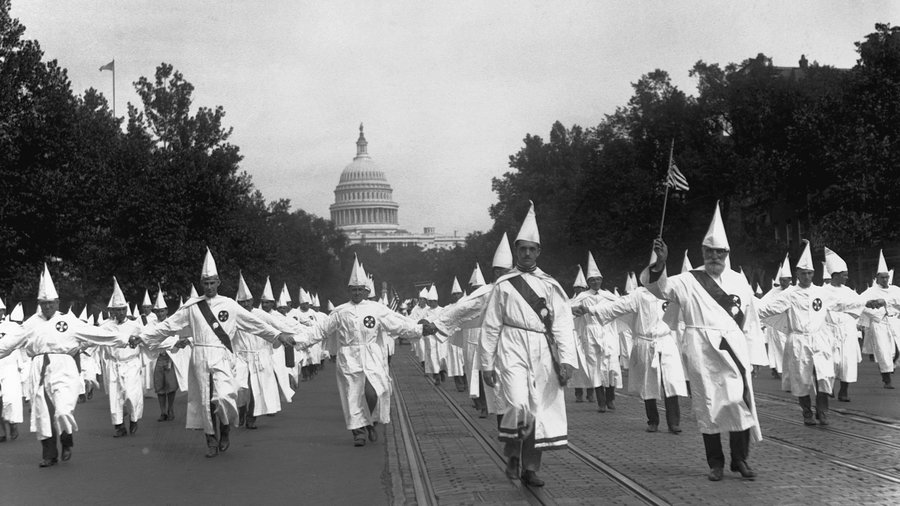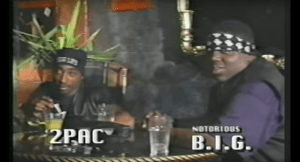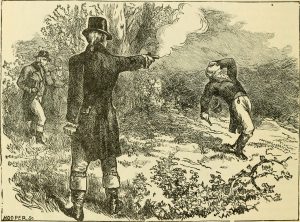Since its origins, the infamous Ku Klux Klan has influenced the attitudes and views of many Americans. The KKK will forever be recognized as the largest political hate group in United States history. Despite the rise and fall of the Klan, it wasn’t until the 1920s that it rose to its highest peak in prominence. During this time period, there was exponential growth in both membership in and support for this notorious cult. The KKK was a growing cult in the 1920s because it instilled religious beliefs, terror, and a skewed view of a better America into the minds of its members through its propaganda of racial superiority.
The original KKK arose during the Reconstruction era of the 1860s and 1870s, and was primarily aimed at restoring the antebellum racial hierarchy to the South. However, it declined in the 1870s due to the passing of legislation aimed at stopping Klansmen’s voter intimidation activities and associated hate crimes. With the end of Reconstruction in 1877, and the passage of Jim Crow laws throughout the South, Klan activity and Klan membership declined. But the cult began a strong resurgence in 1915, with membership skyrocketing to nearly four million by the year 1920.1 This time, the focus of their efforts was aimed at “Americanizing” people by promoting the Constitution, the flag, and the Bible.2 This white supremacist organization lashed out at any group whose ideals conflicted with their own, especially that of African Americans, Catholics, and Jews.

The revival of the Klan was led by its notorious second Grand Wizard (the KKK’s primary leader), William J. Simmons, who was a preacher, a veteran, and an extreme white supremacist.3 He was inspired to reorganize the Klan after watching the silent movie Birth of a Nation, which depicted the Klan as a saving grace, defending the birthright of white southerners and greatly enhancing the public opinion of the cult.4 The religious implications of the KKK stemmed from the teachings of Simmons. Not only were his sermons effective at grasping the hateful minds of Klan members, but he truly convinced them that they were doing the work of God; his credibility led him to a position of power. In fact, one could not join the Klan unless one practiced “militant Christianity,” living in such a way as to be an example to others by following laws, abstaining from drinking, gambling, infidelity, and by not neglecting one’s family. Members were to attend church services regularly, always adhering to the foundations of the Christian faith.5 In addition to this, the KKK burned crosses, often arguing that it was to symbolize the spread of Jesus’ light; it was a symbol aimed to “drive away darkness and gloom.”6 The heavily emphasized morals and negative attitudes toward others are what drove the cult’s frame of thought. Often interpreted in a hateful manner, the religious implications instilled by the KKK’s leaders too often brewed inaccurate thoughts in the minds of its followers; thus, many assumed that the answer to their problem was to commit radical acts of terror.

In addition to their cloaking themselves in the trappings of Christianity, the Klan also used terror tactics to instill fear into both its own members and to those it targeted. The members saw themselves as vigilantes in the restoration of justice—using intimidation, violence, and terror to prevent people of color from attaining any sort of social status or political power. They burned crosses, led beatings, committed assassinations, lynchings, and much more.7 While the symbol of the KKK, the burning cross, held religious connotations for its own members, it was also used as a form of intimidation. They used this symbol of a burning cross to terrorize African Americans.8 In addition to intimidating African Americans, the Klan also targeted Catholics, and had a particularly strong concern with this group due to the fact that they practiced a “different religion” from their own. The motivation for this anti-Catholicism is deeply rooted in American history, going all the way back to colonial times. And with the dramatic increase of Catholics immigrating from Ireland, Italy, and Germany in the nineteenth century, anti-Catholicism was a mainstay throughout American life in the early decades of the twentieth century.9 With the ethnic, social, and racial diversity of American life, tensions continued to heighten among the opposing whites who sought to rid America of these many “outsiders” — a long-held notion in American society. In using both verbal and physical threats, the terror inflicted by the cult caused people to fear the power of the invisible empire that was the KKK.
The idea of creating a better America was yet another reason for the Klan’s rise to prominence in the 1920s. The KKK fought for stricter enforcement of prohibition laws, sought to eliminate political corruption, and wanted to eradicate any form of immigration. Any seemingly “foreign-born” citizen that crossed the path of a klansman was deemed un-American. The Klan assumed they were doing the nation its due diligence in suppressing these “outsiders.” At its peak, the Klan even managed to get political leaders to seek their support and endorsement, since many Americans at this time sympathized with the Klan and its mission.10 And as membership grew, so did their influence. Their opposition to non-whites and to immigration helped to secure the passage of strict quotas on those seeking to come to America.11 The KKK was influential in more ways than one — their power reigning heavily on American society. Even today, white supremacists seek to have their voices heard and their views seen as legitimate. The fight for racial toleration is certainly far from over.

On the other hand, some say that the resurgence of the KKK in the 1920s was due primarily to the effects of industrialization, urbanization, and immigration on society. White Americans became uneasy about immigration and “outsiders” taking American jobs. Many could not stand the idea of “those people” diluting the “racial purity” of American society. But the idea of racial purity is a myth–yet a strong one that many white racists wish to be true. The original soil of America was populated by immigrants and natives alike; whites simply claimed it as their own, as they were to be the guardians of a “city on a hill” and as part of their “manifest destiny” to be the bearers of a supreme culture and society.12 Those that looked to this cult to justify their own beliefs do not parallel with what it means to be an independent individual in American society. The people they were trying to drive out had just as much freedom to be in the United States as they did. Others in support of the Klan also claimed that Simmons was, in fact, preaching for the betterment of society, and that he never resorted to violence to solve problems; though this may seem true, Simmons was actually insinuating his own, twisted version of the word of God, often emphasizing ideas of white supremacy and racial segregation as if that was God’s will. In a pamphlet he wrote in the early nineteenth century, he even states that the primary goal of the organization is to preserve ideals of pure Anglo-Saxon civilization, and many claimed he preached themes of being a pro-American leader by hinting in his sermons that any person in opposition to traditional thought of Anglo supremacy was unwelcome, and simply un-American.13 He silently, yet deviously, instilled discrimination into the Klan’s members. It was even noted that Catholic priests, Protestant ministers, and Jewish rabbis came forward to condemn the organization and its false teachings.14 It seems that the religious implications, terroristic acts, and the skewed ideals used in order to insinuate the making of a better America are contradictory to both the Klan’s mission and the symbols they claimed to uphold.
With a religious basis, the Klan movement emphasized legal and political approaches to solving the “moral crisis” in 1920s America.15 The cult rose to prominence in the 1920s because of their religious, terroristic, and “ideal American” implications; however, their resurgence only served as a detriment. The second coming of the Klan was significant in that it rose to its highest peak in prominence. The KKK’s second coming only continued to fuel the long-held idea of hatred and discrimination that still lingers in the minds of many today.
- Khan Academy, 2016, s.v. “The Reemergence of the KKK,” by Dr. Michelle Getchell. ↵
- David A. Horowitz, Inside the Klavern: The Secret History of a Ku Klux Klan of the 1920s (Carbondale: Southern Illinois University Press, 1999), 10. ↵
- David A. Horowitz, Inside the Klavern: The Secret History of a Ku Klux Klan of the 1920s (Carbondale: Southern Illinois University Press, 1999), 11. ↵
- Roland G. Fryer, “Hatred and Profits: Under the Hood of the Ku Klux Klan,” Quarterly Journal of Economics 127, no. 4 (November 2012): 12. ↵
- Holley Donald, “A Look Behind the Masks: The 1920s Ku Klux Klan in Monticello, Arkansas,” The Arkansas Historical Quarterly no. 2 (2001): 19. ↵
- David Cunningham, “Top 5 Questions About the KKK,” PBS, 2013. Accessed March 12, 2018. http://www.pbs.org/wgbh/americanexperience/features/klansville-faq/. ↵
- Khan Academy, 2016, s.v. “The Reemergence of the KKK,” by Dr. Michelle Getchell. ↵
- PBS, 2013, s.v. “Top 5 Questions About the KKK,” by David Cunningham. ↵
- Mark Paul Richard, Not a Catholic Nation: The Ku Klux Klan Confronts New England in the 1920s (Amherst: University of Massachusetts Press, 2015), 11. ↵
- American Decades, 2001, s.v. “After the Great War: Nativism and the Ku Klux Klan,” by Judith S. Baughman, et.al. ↵
- Gale Encyclopedia of American Law, 2011, s.v. “Ku Klux Klan,” by Donna Batten. ↵
- Khan Academy, 2016, s.v. “The Reemergence of the KKK,” by Dr. Michelle Getchell. ↵
- William J. Simmons, “Pamphlet for the Ku Klux Klan Written by Colonel William Joseph Simmons,” Smithsonian, 2017. Accessed April 6, 2018. https://nmaahc.si.edu/object/nmaahc_2011.155.15. ↵
- Khan Academy, 2016, s.v. “The Reemergence of the KKK,” by Dr. Michelle Getchell. ↵
- Holley Donald, “A Look Behind the Masks: The 1920s Ku Klux Klan in Monticello, Arkansas,” The Arkansas Historical Quarterly no. 2 (2001): 14-15. ↵




122 comments
Anthony Dinh
I thought it was interesting that the KKK did not only larked the African Americans, but other christian groups who were not in support of their beliefs. The article was well written well, the excuses or reasoning behind why they restarted this movement and all is interesting. It would be interesting to know what was going through there brain during this time, and to be able to understand their hatred towards these groups of people.
Amelie Rivas-Berlanga
This article did a great job at explaining all the ways the KKK targeted different religions and races. It is interesting to see that the clan is still active. The origin story surprised me, I thought that they always had the same morals and agenda. The KKK is a perfect example of what happens to a group of individuals who are uneducated and carry the beliefs of their ancestors. This article does a great job of describing the clan and their agendas throughout time.
Cecilia Schneider
One of the worst parts of the cult, besides their racial terrorism, is that their existence is ironically contradicting. I believe the KKK holds the religion of Protestant Christianity, which originated from Catholicism. The religion the klan is against is the basis of their own religion. Another aspect of irony, although it is much deeper than irony, is that the cult opposed “outsiders” which is exactly how Americans began. We were originally immigrants who sought America. We were the outsiders at one point, and we drove out the natives, who were the original citizens of this land. Their symbols do the opposite of depicting Jesus and his “light.” It instills much more than fear, and even from the pictures, I had chills. The KKK brought the “gloom” they were trying to rid of. Basically, the KKK is and does what they oppose.
Luis Molina Lucio
Very great paper with information that many people do not really know about the KKK. As I kept on reading the article, I really realized how much influence the KKK had on U.S society. The KKK had its goals, and it is surprising to me that most of their doings were attempted to be justified with religion. Overall informative article that really conveys who the KKK was.
Lily Schow
It was very interesting to learn that the KKK was not always a religious white supremacist group. They are always depicted as a heavily religious group, so I figured they had always been. This article is very well written for such a hard topic. Although it may be hard to talk about this part of history, we have to, so that white supremacist groups like the KKK can not ever have as much power as the group did during the 20’s and 30’s. The article helped to give the full picture of where a group as horrible as the KKK came from.
Sara Davila
I commend the author for writing about a society that is so controversial and hated. Kimberly Simmons did a great job introducing the organization is a non-biased manner, and organizing the article in a format that gave the reader some back story on the leader of the Klan, William J. Simmons. I also noted how the author added how the movie “Birth of a Nation” heavily influenced these racist feelings towards non-whites. I also liked how the author noted how these feelings still linger today.
Dylan Miller
This article was a very informative piece. While I knew that the KKK was around for a long time, I never knew that they started in the Reconstruction era, let only die and come back around 1920. It’s interesting to know about the reasoning that these horrible acts caused by these people happened, and how they actually believed these acts were done for God or done in “God’s will”. The fact that this group was even popular enough to have thousands of members is disgusting. On the other hand, something that isn’t disgusting and is really good is this article! Especially the informative writing style and use of real authentic pictures of the klan and their second “grand wizard” William J. Simmons.
Geraldine Fry
This article was very informative, and I learned a lot about the KKK. I had never known that the KKK was a religious and moral organization. They believed in Christianity and were strong Christians that had high morals like not drinking and following the law. I had always assumed it was just a bunch of white angry people that thought themselves better, I had no idea they had any at all morals and were religious! I suppose this was a way they justified such horrific crimes, while not feeling guilty.
Gabriella Parra
From my youth, the Klu Klux Klan has always scared me, from their costumes to their ideology. Because of that, I never learned much about them. That is why I’m glad your article was so dense with information. I had no idea they targeted Catholics and I did not know they were a Protestant organization, although it’s not surprising. I’d be interested to see a timeline of the group’s popularity or membership and compare that with the prevailing ideas of the decades in America.
Briana Gonzalez
It’s crazy how I’ve heard of the KKK, but I’ve never learned about it fully, reading this article gave me a full illustration. The detailing of what they believed in and what they did, help me visualize the event in real life. It shocks me that to this day the KKK cult still exists, and people still join. Simmons was in the wrong for this and thought he was doing the right for getting rid of non-Americans.